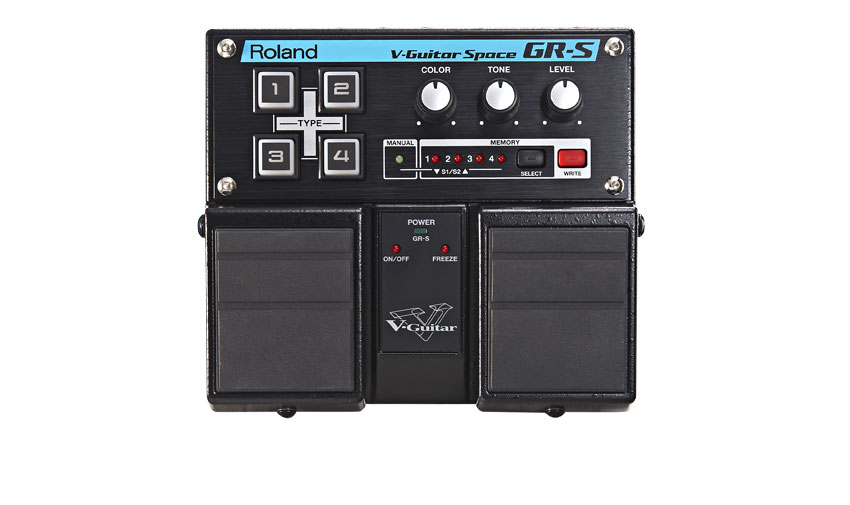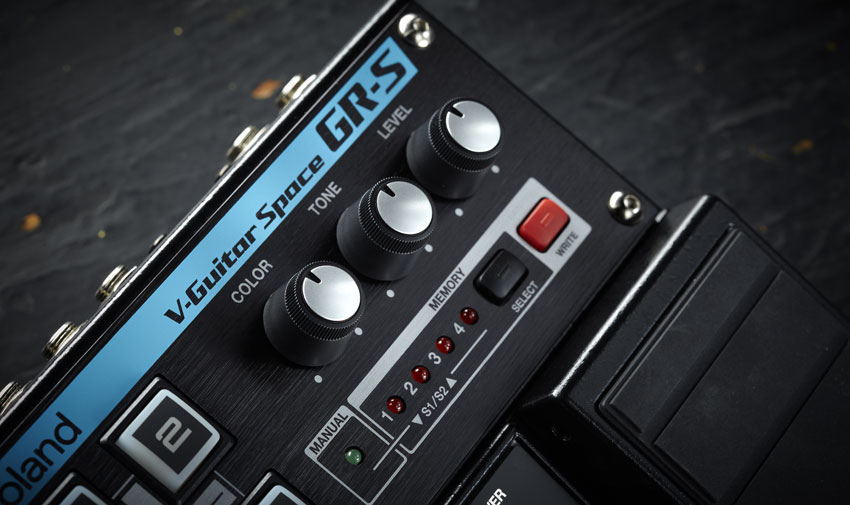MusicRadar Verdict
If you want some high-tech variations on the ambient chorus theme, this pedal offers those, and is a cost-effective way to buy into the V-Guitar world.
Pros
- +
Nice variety of floaty sounds. Freeze function. Squidgy pads for effect selection.
Cons
- -
Full potential is not reached if you're using a conventional guitar.
MusicRadar's got your back

Roland GR-S V-Guitar Space review

Controls
For players willing to embrace it, Roland's V-Guitar system offers an awful lot - it can deliver many sounds that are simply not available from a conventional pedal and amp setup. Now the GR-S V-Guitar Space offers a portion of V-Guitar technology in a Boss Twin Pedal chassis.
Roland's V-Guitar system is not exactly a budget buy, and requires the use of a guitar equipped with a divided pickup, such as Roland's GK-3, and its 13-pin connection - a further investment that can put many off.
That may have been the end of the matter at one time, but not any more: if you'd like some of those sounds without shelling out for a full-blown VG-99 or would like access to them from a conventional electric guitar, Roland has made it possible with the release of a new pedal, the GR-S V-Guitar Space.
Build
It has a divided-pickup guitar input, but also has a pair of standard jack inputs, plus outputs to connect to an amp or pedals.
If you're using a standard guitar, you simply connect it to the L (mono) input and use the jack outputs for either stereo or mono operation. Roland does point out, though, that you won't be able to enjoy the full potential of the GRs using a conventional guitar, since the signal from each string can't be processed individually.
"The GR-S creates its sounds by applying independent processing for each guitar string"
If you are using a GK pickup, there's also a Guitar Out socket, so you can send the normal clean pickup signals of the GK-compatible guitar to another device - perhaps an effects unit, the output of which can then be connected to the GR pedal's jack inputs in a send/ return scenario, if desired.
The pedal features four different sounds that you can select and tweak manually. Besides this manual mode, you also get four user memories that store and recall any sound you create, regardless of how the knobs are physically set. These are cycled with a single button or accessed by the patch up and down buttons if you're using the pedal with a GK pickup.
The GR-S creates its sounds by applying independent processing for each guitar string. It has a tone knob that brightens the sound, and a Color knob that has a different function for each of the four effects: crystal, rich modulation, slow pad and brilliant clean.
The right-hand footswitch operates a freeze effect, which creates an instant loop of the sound and sustains it for as long as you hold it down, letting you solo over it.
Sounds
With a conventional guitar, the GR-S is basically a fancy chorus pedal - you get four different flavours of modulation and pitch effects combined with ambience, each with Color knob adjustment, which brings in metallic resonance, more modulation or the like. Use a divided pickup (like the one on our Roland GK-3-equipped Yamaha Pacifica), though, and it comes to life with more detail and depth.
This is typified by the slow pad effect, a lovely evolving sound, which has an attack that swells in according to the setting of the Color knob, a feature absent with a normal axe. The other sounds provide crystalline modulation with an icy metallic edge, very spacious chorusing and faux 12-string (or even 18-string) sounds...
We do like the idea that Roland has equipped this pedal to make some part of its VG and GR sounds available to anyone playing a regular guitar. However, that is not the primary focus here - while this pedal can certainly add something a little different to your tonal palette and still fit into your basic pedal setup, their full sonic potential is not realised in this way.
"With a divided pickup, buying this pedal makes much more sense"
What's more, it's a lot pricier than conventional stompboxes, and although that probably reflects the fact that it's filled with more expensive electronic gubbins than most, you'd have to have a good listen and think very hard about adding it to your 'board.
With a divided pickup though, buying this pedal makes much more sense. This pedal really does respond differently and provide a deeper, more stunning range of effects if you're using a GK pickup.
Not only will you will get optimum use out of it in that scenario but it offers an ideal opportunity to buy into the V-Guitar world for a lot less than shelling out for a VG-99. It could be a worthwhile buy if you already have a guitar fitted with a GK pickup or are thinking of adding one to your guitar and dipping your toe in the VG/GR water.
Trevor Curwen has played guitar for several decades – he's also mimed it on the UK's Top of the Pops. Much of his working life, though, has been spent behind the mixing desk, during which time he has built up a solid collection of the guitars, amps and pedals needed to cover just about any studio session. He writes pedal reviews for Guitarist and has contributed to Total Guitar, MusicRadar and Future Music among others.
“Built from the same sacred stash of NOS silicon transistors and germanium diodes, giving it the soul – and snarl – of the original”: An octave-fuzz cult classic returns as Jam Pedals resurrects the Octaurus
What’s the buzz? Meet Yellowjacket, Cherry Audio's recreation of EDP’s trend-setting Wasp from 1978
“A fabulous trip through all eight songs by 24 wonderful artists and remixers... way beyond anything I could have hoped for”: Robert Smith announces new Cure remix album










